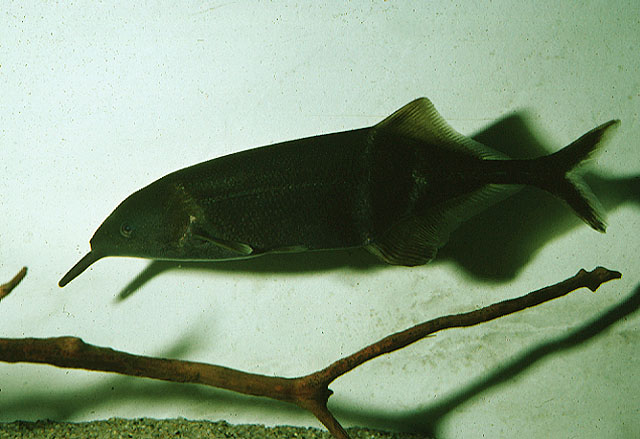
In addition to returning friends like the freshwater rays and the gars, there are also a few new species on display. Some of the most charismatic of the newbies are the two species of elephantnose fish (also known simply as “elephantfish”). Have you seen them!?
Elephantnose Overview
Elephantnose fish are in the order Osteoglossiformes, the sub-order Notopteroidei and the family Mormyridae. There are an estimated 200 species in this family ranging in sizes from 5 cm to 1.5 m. While not all species have the characteristic trunk-like appendage, they all have the ability to generate a weak electric field to help navigate their turbid environments.
We have two separate species in the Ancient Fishes Exhibit here at the Aquarium. The vast majority of the large school are known as Peter’s elephantnose (Gnathonemus petersii) and there is one specimen of the longfinned elephantnose (Brienomyrus longianalis).
Peter’s Elephantnose (Gnathonemus petersii)

Photo: Jacque Moreau via fishbase
Habitat: Rivers of west and central Africa - prefers muddy, slow moving rivers with cover
Size: Averages 23-25 cm in length
Diet: Insects and worms
Life-span: Estimated at 6-10 years
Peter’s elephantnose have the elephant trunk-like protrusion. While their name implies it is their nose, it is actually an appendage attached to their lower jaw. This sensitive apparatus is known to be used in communication, self defense, navigation and for locating prey.
Longfinned Elephantnose (Brienomyrus longianalis)

Photo: RMCA via fishbase
Habitat: Similar to that of Peter’s elephantnose
Size: Approximately 16 cm max length
*There is far less known about this species
Unlike Gnathonemus p., the longfinned elephantnose does not contain the trunk-like appendage implied by their name. In addition, while the Peter’s elephantnose’s anal and dorsal fins are equal in length, the longfinned elephantnose gets its name from the anal fin, which is much longer than its dorsal fin.
Elephantnose and the Electric Eel – A Story of Convergence
What do elephantnose fish and electric eels have in common? No, not just that their names are both fairly misleading, they also both emit electrical fields to sense their environment and locate prey. This is a fascinating example of convergent evolution – two unrelated animals developing similar adaptations over time.The elephantnose fish have a brain to body size ratio similar to that of humans! Much scientific research has been dedicated to study how elephantfish use weak electric fields to sense their surroundings and possibly to communicate. Perhaps their cerebellum is so enlarged to help them interpret bio-electrical signals. [We recently posted about a new exhibit that shows how whales and dolphins communicate and navigate their surroundings! Check it out.]
While these species of elephantnose are themselves species of least concern, they share their freshwater habitats with other species in need of our protection. River habitats in Africa face many of the same issues as rivers all over the world (pollution, damming, overfishing, etc) so these fish can be used to inspire each of us to think about how our local actions impact global ecology.

0 comments:
Post a Comment